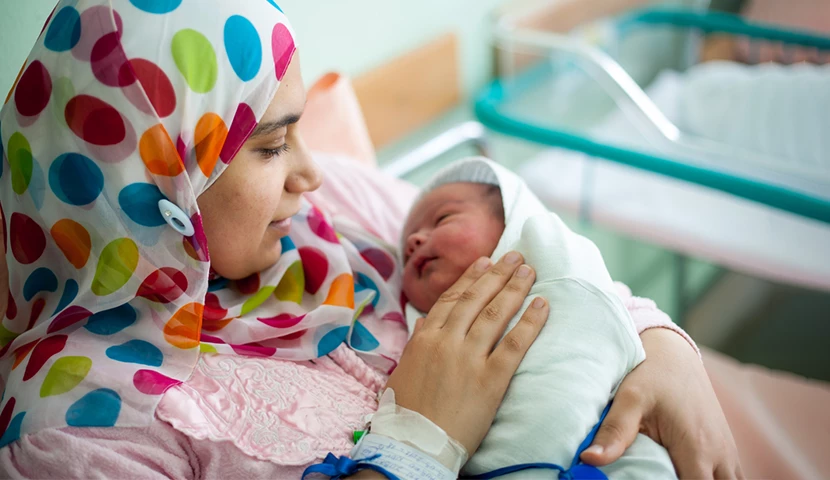
The United Nations Inter-agency Group for Child Mortality Estimation (UN IGME) released its first-ever global stillbirth estimates today. According to the new report: A Neglected Burden: The Global Tragedy of Stillbirths, stillbirths were on a downward trend prior to the outbreak of COVID-19. But the numbers were still enormous: 1.9 million babies were stillborn globally in 2019 —that’s one stillbirth every 16 seconds.
This is in addition to the 2.4 million neonatal deaths in 2019—in a strict demographic sense, stillbirths are not even counted as deaths because one needs to be born alive to die.
The estimated 1.9 million stillborn babies equates to a global stillbirth rate of 13.9 stillbirths per 1,000 total births (total birth is the sum of stillbirths and live births). Stillbirths are often underreported, so it is possible that even these numbers are underestimated.
Countries do not experience this loss uniformly, with national stillbirth rates ranging from 1.5 stillbirths to 32 stillbirths per 1,000 total births. Countries with the highest stillbirth rates are all in Sub-Saharan Africa or South Asia, namely Guinea-Bissau, Pakistan, Central African Republic, South Sudan and Afghanistan. As with the under-five mortality rate or the neonatal mortality rate, Sub-Saharan Africa and South Asia bear the greatest burden of stillbirths in the world at roughly 77% of estimated stillbirths in 2019. The lowest rates were estimated for North America (3.0 stillbirths per 1,000 total births) and Europe and Central Asia (4.1).
Progress in reducing stillbirth rate is slower than in reducing the under-five mortality rate
There is global progress in reducing the number of stillbirths; however, this improvement still falls short of the strides made in reducing the number of under-five deaths. Between 2000 and 2019, the number of under-five deaths declined from 9.7 million to 5.2 million—a reduction of 47%. The corresponding reduction for stillbirths was just 33% (from 2.9 million to 1.9 million).
A similar comparison holds for rates. From 2000 to 2019, the global rate of under-five mortality declined by 50% (from 75.8 deaths per 1,000 live births to 37.7 deaths) while the corresponding reduction in the rate of stillbirths (number per 1,000 total births) was just 36% (from 21.6 to 13.8). Clearly, the improvement for stillbirths does not match that of under-five mortality.
Progress also varied across regions. Among regions with stillbirth rates above 12 stillbirths per 1,000 total births in 2000, East Asia and Pacific achieved the fastest progress between 2000 and 2019 in reducing the stillbirth rate (a 51% reduction). The corresponding decline in Sub-Saharan Africa was slowest with a reduction of 23%. As a result, stillbirths are increasingly concentrated in Sub-Saharan Africa.
The impact of COVID-19
In our earlier blog, we wrote about the concerning effects of COVID-19 on the decades of progress in reducing child mortality. Likewise, stillbirths are likely to increase this year due to weakened health care systems and reduced access to quality care.
The 2014 Ebola outbreak substantially reduced antenatal care visits and access to institutional deliveries. Additionally, lack of access to family planning can increase the number of unplanned pregnancies with higher risks of miscarriage or stillbirth.
Improved health systems including high-quality antenatal and delivery care are critical to ending preventable stillbirths, and the focus must be maintained despite the pressures of the pandemic. An integrated programmatic approach should be applied to the continuum of care for women and children. Urgent action is needed to avert stillborn deaths and ensure every woman is being supported through pregnancy and childbirth by trained health care providers.
For more detailed discussion, please see The Lancet article.
These stillbirth estimates were produced by the UN IGME. The UN IGME includes UNICEF, the World Health Organization, the World Bank Group, and the United Nations Population Division as full members. The group was formed in 2004 to share data on mortality, harmonize estimates within the UN system, improve methods for child mortality estimation, and to report on progress towards the MDGs. The group started its work on estimating stillbirth indicators in 2018 and just released its first-ever stillbirth trend estimates. The group continues to produce reliable and transparent mortality estimates to track countries’ progress towards SDG target 3.2. All data, estimates, and details on methods are available on the Child Mortality Estimates website. The new stillbirth estimates are also available in the World Bank’s HealthStats database.



Join the Conversation